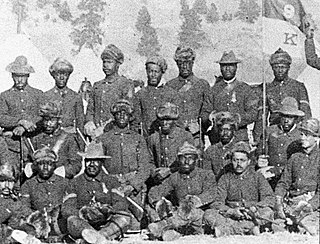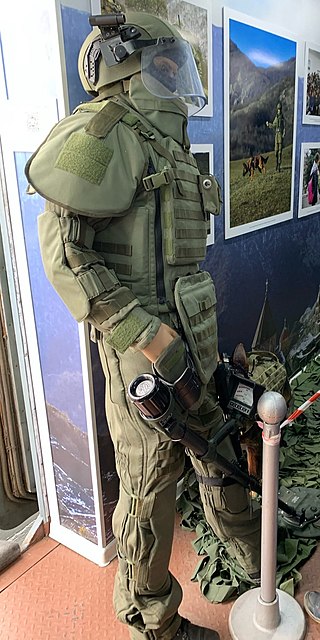
A troop is a military sub-subunit, originally a small formation of cavalry, subordinate to a squadron. In many armies a troop is the equivalent element to the infantry section or platoon. Exceptions are the US Cavalry and the King's Troop Royal Horse Artillery where a troop is a subunit comparable to an infantry company or artillery battery. Historically the remainder of the Royal Horse Artillery used the term troop in the same manner but they eventually aligned with the rest of the Royal Regiment of Artillery in referring to troops as subordinate to artillery batteries.

A sapper, also called a combat engineer, is a combatant or soldier who performs a variety of military engineering duties, such as breaching fortifications, demolitions, bridge-building, laying or clearing minefields, preparing field defenses, and road and airfield construction and repair.

Yeomanry is a designation used by a number of units and sub-units in the British Army Reserve which are descended from volunteer cavalry regiments that now serve in a variety of different roles.

The 8th Infantry Division was an infantry division of the British Army that was active in both the First and Second World Wars. The division was first formed in October 1914 during the First World War, initially consisting mainly of soldiers of the Regular Army and served on the Western Front throughout the war, sustaining many casualties, before disbandment in 1919. The division was reactivated in Palestine, under the command of Major-General Bernard Montgomery, in the late 1930s in the years running up to the Second World War before being disbanded in late February 1940. It was briefly reformed in Syria in an administrative role during 1942-3.

The Royal Australian Engineers (RAE) is the military engineering corps of the Australian Army. The RAE is ranked fourth in seniority of the corps of the Australian Army, behind the Staff Cadets, Armoured and Artillery Corps. The corps was formed by the amalgamation of the various colonial engineer corps of the states and territories of Australia in 1902 and since then has served in various conflicts including World War I, World War II and the Vietnam War. The corps has also served on numerous peacekeeping operations and was heavily involved in the Australian contribution to the war in Afghanistan.

The Indian Army Corps of Engineers is a combat support arm which provides combat engineering support, develops infrastructure for armed forces and other defence organisations and maintains connectivity along the borders, besides helping the civil authorities during natural disasters. College of Military Engineering, Pune (CME) is the premier technical and tactical training institution of the Indian Army Corps of Engineers.
5th Engineer Regiment is a Reserve unit of the Royal Australian Engineers. Originally raised as the "5th Combat Engineer Regiment" in 1995 from the 4th Field Engineer Regiment, it is based in Holsworthy, Sydney, with one of its sub-units based at the multi-user depot HMAS Harman, in Canberra and another at Orchard Hills and Dundas. Some of the unit's subunits draw lineage from the 4th and 5th Field Companies, which were raised for service during World War I.
Army 2020 Refine was the name given to the restructuring of the British Army in the mid-to-late 2010s, in light of the Strategic Defence and Security Review 2015. As its name suggests, it was a "refinement" of Army 2020, an early 2010s reorganisation of the Army to be completed by 2020, originally conducted in light of the Strategic Defence and Security Review 2010.

A squadron was historically a cavalry subunit, a company- or battalion-sized military formation. The term is still used to refer to modern cavalry units, and is also used by other arms and services. In some countries, including Italy, the name of the battalion-level cavalry unit translates as "Squadron Group".

The 1st Anti-Aircraft Division was an Air Defence formation of the British Army before and during the early years of the Second World War. It defended London during the Battle of Britain and The Blitz.
7 Regiment RLC is a regiment of the British Army's Royal Logistic Corps.

The 2nd Anti-Aircraft Division was an Air Defence formation of the British Army from 1935 to 1942. It controlled anti-aircraft gun and searchlight units of the Territorial Army (TA) defending the East Midlands and East Anglia during The Blitz.
London District Signals was a headquarters signal unit of the Royal Engineers (RE) and later Royal Corps of Signals in Britain's Territorial Army from 1908. It served with a corps headquarters at Gallipoli and on the Western Front during World War I, and later became an air defence signal unit during World War II. Its successor unit continues in the Army Reserve today.

The School of Engineers is part of the South African Army Engineer Formation, which provides combat engineering corps training and teaching to military officers and personnel as well as other Military Schools throughout the South African National Defence Force. They are currently the only Military School in Southern Africa to formally present IEDD.

The 4th Anti-Aircraft Division was an air defence formation of Britain's Territorial Army, created in the period of tension before the outbreak of the Second World War. It defended North West England during the Blitz.

The page contains the current structure of the British Army. The British Army is currently being reorganised to the Future Soldier structure.

The 1st Regiment is a light infantry battalion of the Armed Forces of Malta. The Regimental Headquarters is at Lyster Barracks in Ħal Far. Lyster Barracks was a former Royal Navy and Royal Air Force barracks and originally named after Vice Admiral Sir Arthur Lumley St George Lyster. Admiral Lyster commanded the Fleet Air Arm force that protected the Operation Pedestal convoy force to Malta during World War 2. The current barracks site includes some of the original British military architecture and four of the accommodation blocks are named after famous Royal Navy aircraft carriers, some of whom were frequent visitors to Malta; i.e. Glorious, Courageous, Eagle and Hermes

The 7th Anti-Aircraft Division was an air defence formation of the British Army during the early years of the Second World War. It defended North East England during the Battle of Britain and The Blitz.
28 Engineer Regiment (C-CBRN), Royal Engineers is a regiment of the British Army that focuses on countering chemical, biological, radiological and nuclear (C-CBRN) hazards in the environment. Its operational chain of command is 29 Group, under 8th Engineer Brigade as part of 1st (UK) Division.













